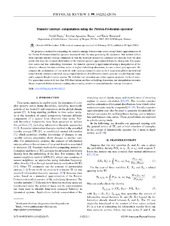Transfer entropy computation using the Perron-Frobenius operator
Peer reviewed, Journal article
Published version

Åpne
Permanent lenke
https://hdl.handle.net/1956/21882Utgivelsesdato
2019Metadata
Vis full innførselSamlinger
- Department of Earth Science [1103]
Originalversjon
https://doi.org/10.1103/physreve.99.042212Sammendrag
We propose a method for computing the transfer entropy between time series using Ulam's approximation of the Perron-Frobenius (transfer) operator associated with the map generating the dynamics. Our method differs from standard transfer entropy estimators in that the invariant measure is estimated not directly from the data points, but from the invariant distribution of the transfer operator approximated from the data points. For sparse time series and low embedding dimension, the transfer operator is approximated using a triangulation of the attractor, whereas for data-rich time series or higher embedding dimension, we use a faster grid approach. We compare the performance of our methods with existing estimators such as the k nearest neighbors method and kernel density estimation method, using coupled instances of well known chaotic systems: coupled logistic maps and a coupled Rössler-Lorenz system. We find that our estimators are robust against moderate levels of noise. For sparse time series with less than 100 observations and low embedding dimension, our triangulation estimator shows improved ability to detect coupling directionality, relative to standard transfer entropy estimators.